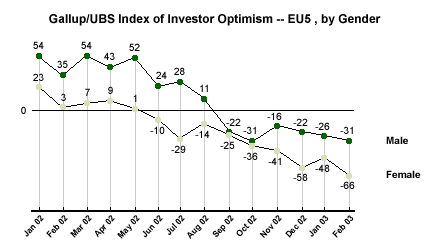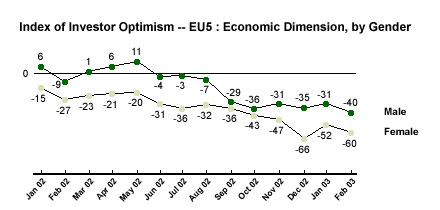"Ginger Rogers did everything that Fred Astaire did. She just did it backwards and in high heels," said former Texas Gov. Ann Richards, describing women's historical political efforts. The analogy is apt in a couple of other ways, too. It describes the differences in investor optimism -- and investor difficulties -- between men and women. It also illustrates the difference between European and American investors. Male investors are typically more optimistic than female investors when it comes to investments, just as Americans are typically more optimistic than Europeans. And because they have less money on average, investing is often more difficult for women and Europeans. The results of the Gallup/UBS Index of Investor Optimism -- EU5* show just what one might expect -- European women are the most pessimistic of all investors.
A Dark Year in the Old World
The year 2002 was not a happy one for European investors. The threat of terrorism was ever-present, and a war with Iraq became ever more likely. The European economy was weak, and the dismal American economy reduced their trade opportunities. European investors, especially women, began to lose what little optimism they had.
In February 2002, overall optimism on the Index of Investor Optimism -- EU5 (made up of investors in England, France, Germany, Italy, and Spain) stood at 35 for male investors. That level indicates considerable pessimism, but female investors were at 3. By February 2003, overall optimism among European men had plunged to -31, and women investors were twice as pessimistic at -66. That is the lowest single score ever given by either men or women on either the American or European Indexes of Investor Optimism.

The Economic Dimension
Europeans have reason to eschew optimism about the economy, and probably will for some time. Female investors have particular cause to be less sanguine than male investors. Like American women, they tend to earn less in a lifetime, but cultural differences may also heighten their aversion to risk and therefore influence the relative position of men and women on the Index differently in Europe than in America.
In February 2002, women were at -27 on the Economic Dimension of the Index; men were at -9. Over the course of the year, female investor optimism showed an incremental and inexorable slide downward, arriving at -60 by February 2003. Male investors' hopes for the economy were more volatile. In February 2002, they were at 6 on the Economic Dimension, then down to -9 the next month, up to 11 in May, and down to -7 in August. At that point, whatever gnawed at women investors started chewing on men, too. By September 2002, men's optimism on the Economic Dimension moved down to -29, and eventually arrived at -40 in February 2003.

The Personal Dimension
The Personal Dimension of the Index tends to move more slowly -- and exhibit more optimism -- than the Economic Dimension. It's also more predictive of future investor sentiment. In February 2002, women's optimism on the Personal Dimension was at 30 -- hardly cheerful, but not fatal. In 12 months, female optimism sunk to -6. Men were a bit happier in 2002, at 44 in February. The trajectory of their optimism on the Personal Dimension, though slightly bumpier, was much like women's. By last month, they were at 9. Considering the predictive quality of the Personal Dimension of the Index of Investor Optimism, 2003 doesn't look rosy for European investors.

Bottom Line
Traditional stereotypes have it that: 1) Women tend to be more risk-averse, which can dispose them to look askance at the market when it slopes; and 2) Americans tend to be more optimistic than Europeans, inclining them to see hope springing eternal. To the extent that those stereotypes hold true, perhaps they can help explain the differences in investor optimism between Americans and Europeans – as well as those between men and women.
*Results for the Index of Investor Optimism -- EU5 are based on interviews with approximately 200 investors each in France, Germany, Great Britain, Italy, and Spain conducted monthly between January 2002 and February 2003. The interview composition was 53% male and 47% female. In addition to sampling error, question wording and practical difficulties in conducting surveys can introduce error or bias into the findings of public opinion polls.

